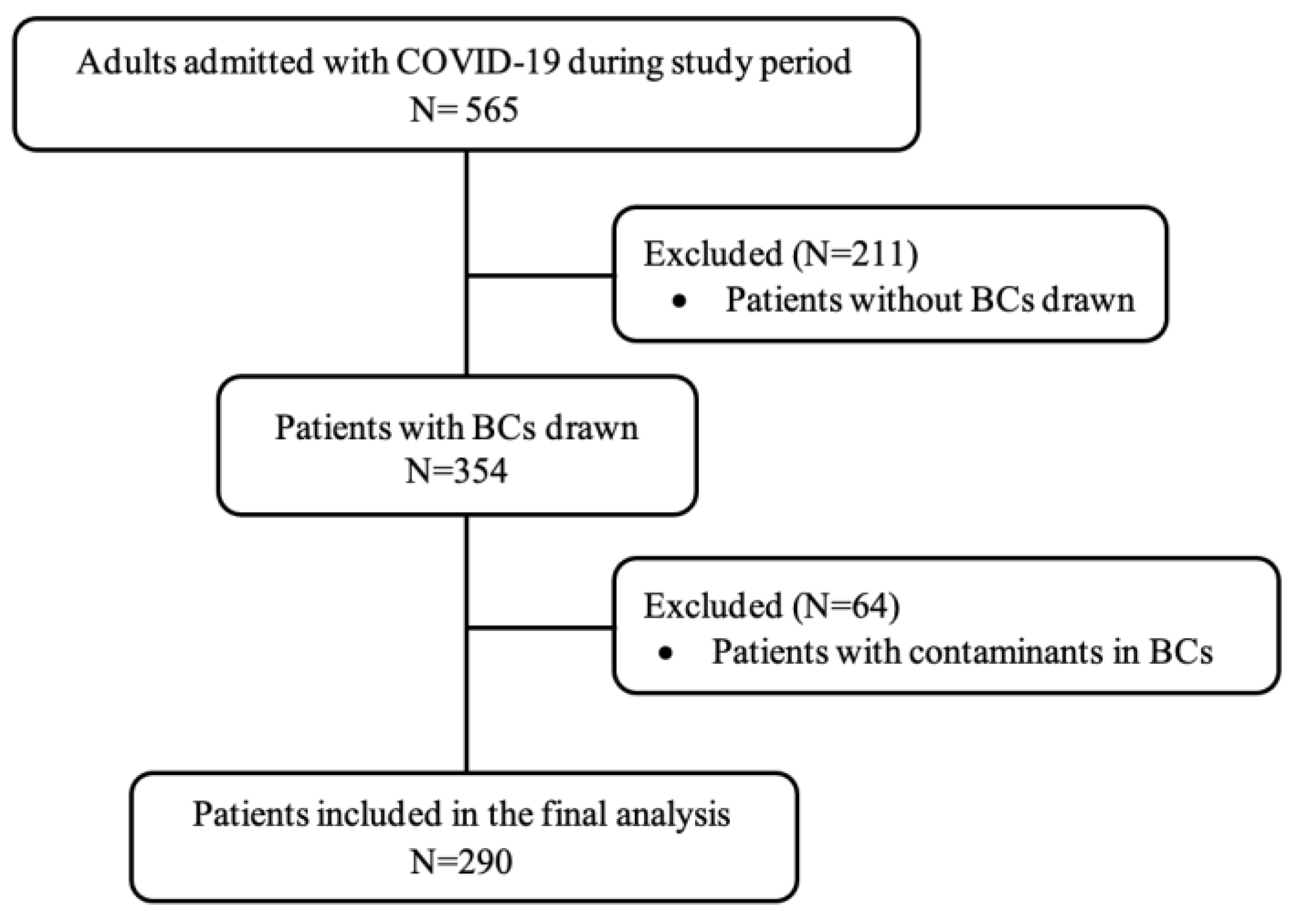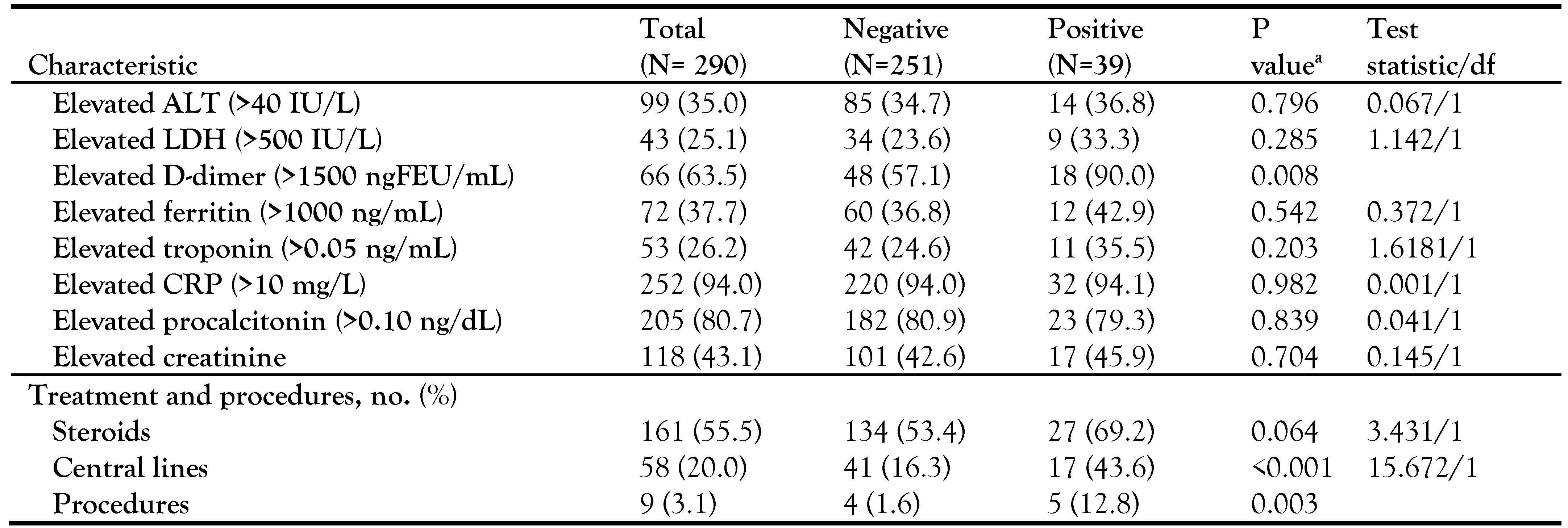Incidence of Bloodstream Infections in Patients with COVID-19: A Retrospective Cohort Study of Risk Factors and Outcomes
Abstract
Introduction
Methods Study subjects
Data collection
Data analysis
Results
Discussion
Conclusions
Supplementary Materials
Author Contributions
Funding
Conflicts of interest
References
- Johns Hopkins Coronavirus Resource Center. COVID-19 Map—Johns Hopkins Coronavirus Resource Center. 2020.
- Wiersinga, W.J.; Rhodes, A.; Cheng, A.C.; Peacock, S.J.; Prescott, H.C. Pathophysiology, transmission, diagnosis, and treatment of coronavirus disease 2019 (COVID-19): A review. JAMA. 2020, 324, 782–793. [Google Scholar] [CrossRef] [PubMed]
- Suleyman, G.; Fadel, R.A.; Malette, K.M.; et al. Clinical characteristics and morbidity associated with coronavirus disease 2019 in a series of patients in Metropolitan Detroit. JAMA Netw Open. 2020, 3, e2012270. [Google Scholar] [CrossRef] [PubMed]
- Martín-Loeches, I.; Sanchez-Corral, A.; Diaz, E.; et al. Community-acquired respiratory coinfection in critically ill patients with pandemic 2009 influenza A(H1N1) virus. Chest 2011, 139, 555–562. [Google Scholar] [CrossRef] [PubMed]
- Sepulveda, J.; Westblade, L.F.; Whittier, S.; et al. Bacteremia and blood culture utilization during COVID-19 surge in New York City. J Clin Microbiol. 2020, 58, e00875–e20. [Google Scholar] [CrossRef]
- Goyal, P.; Choi, J.J.; Pinheiro, L.C.; et al. Clinical characteristics of COVID-19 in New York City. N Engl J Med. 2020, 382, 2372–2374. [Google Scholar] [CrossRef]
- Hughes, S.; Troise, O.; Donaldson, H.; Mughal, N.; Moore, L.S.P. Bacterial and fungal coinfection among hospitalized patients with COVID-19: A retrospective cohort study in a UK secondary-care setting. Clin Microbiol Infect. 2020, 26, 1395–1399. [Google Scholar] [CrossRef]
- Ripa, M.; Galli, L.; Poli, A.; et al. Secondary infections in patients hospitalized with COVID-19: Incidence and predictive factors. Clin Microbiol Infect. 2021, 27, 451–457. [Google Scholar] [CrossRef]
- Yu, D.; Ininbergs, K.; Hedman, K.; Giske, C.G.; Strålin, K.; Özenci, V. Low prevalence of bloodstream infection and high blood culture contamination rates in patients with COVID-19. PLoS ONE. 2020, 15, e0242533. [Google Scholar] [CrossRef]
- Bhatt, P.J.; Shiau, S.; Brunetti, L.; et al. Risk factors and outcomes of hospitalized patients with severe coronavirus disease 2019 (COVID-19) and secondary bloodstream infections: A multicenter case-control study. Clin Infect Dis. 2021, 72, e995–e1003. [Google Scholar] [CrossRef]
- Cataldo, M.A.; Tetaj, N.; Selleri, M.; et al. Incidence of bacterial and fungal bloodstream infections in COVID-19 patients in intensive care: An alarming “collateral effect. ” J Glob Antimicrob Resist. 2020, 23, 290–291. [Google Scholar] [CrossRef]
- Goto, M.; Al-Hasan, M.N. Overall burden of bloodstream infection and nosocomial bloodstream infection in North America and Europe. Clin Microbiol Infect. 2013, 19, 501–509. [Google Scholar] [CrossRef]
- Bhargava, A.; Sharma, M.; Riederer, K.; Fukushima, E.A.; Szpunar, S.M.; Saravolatz, L. Risk factors for in-hospital mortality from coronavirus disease 2019 infection among black patients-an urban center experience. Clin Infect Dis. 2021, 73, e4005–11. [Google Scholar] [CrossRef] [PubMed]
- Expert Panel on the Identification, Evaluation, and Treatment of Overweight in Adults. Clinical guidelines on the identification, evaluation, and treatment of overweight and obesity in adults: Executive summary. Am J Clin Nutr. 1998, 68, 899–917. [Google Scholar] [CrossRef] [PubMed]
- Charlson, M.E.; Pompei, P.; Ales, K.L.; MacKenzie, C.R. A new method of classifying prognostic comorbidity in longitudinal studies: Development and validation. J Chronic Dis. 1987, 40, 373–383. [Google Scholar] [CrossRef] [PubMed]
- World Health Organization (WHO) 2020. Clinical management of COVID-19 Geneva: W.H.O. Available online: https://www.who.int/publications/i/item/clinical- management-of-covid-19 (accessed on day month year).
- Khwaja, A. KDIGO clinical practice guidelines for acute kidney injury. Nephron Clin Pract. 2012, 120, c179–c184. [Google Scholar] [CrossRef]
- Seymour, C.W.; Liu, V.X.; Iwashyna, T.J.; et al. Assessment of clinical criteria for sepsis for the third international consensus definitions for sepsis and septic shock (Sepsis- 3). JAMA 2016, 315, 762–774. [Google Scholar] [CrossRef]
- Massart, N.; Maxime, V.; Fillatre, P.; et al. Characteristics and prognosis of bloodstream infection in patients with COVID-19 admitted in the ICU: An ancillary study of the COVID-ICU study. Ann Intensive Care. 2021, 11, 183. [Google Scholar] [CrossRef]
- Wu, X.; Liu, L.; Jiao, J.; Yang, L.; Zhu, B.; Li, X. Characterisation of clinical, laboratory and imaging factors related to mild vs. severe COVID-19 infection: A systematic review and meta-analysis. Ann Med. 2020, 52, 334–344. [Google Scholar] [CrossRef]
- Mohamed, M.S.; Moulin, T.C.; Schiöth, H.B. Sex differences in COVID-19: The role of androgens in disease severity and progression. Endocrine 2021, 71, 3–8. [Google Scholar] [CrossRef]
- Aziz, M.; Fatima, R.; Lee-Smith, W.; Assaly, R. The association of low serum albumin level with severe COVID-19: A systematic review and meta-analysis. Crit Care. 2020, 24, 255. [Google Scholar] [CrossRef]
- Wiedermann, C.J. Hypoalbuminemia as surrogate and culprit of infections. Int J Mol Sci. 2021, 22, 4496. [Google Scholar] [CrossRef]
- Lippi, G.; Plebani, M. Laboratory abnormalities in patients with COVID-2019 infection. Clin Chem Lab Med. 2020, 58, 1131–1134. [Google Scholar] [CrossRef]
- Guan, W.J.; Ni, Z.Y.; Hu, Y.; et al. Clinical characteristics of coronavirus disease 2019 in China. N Engl J Med. 2020, 382, 1708–1720. [Google Scholar] [CrossRef]
- Borakati, A.; Perera, A.; Johnson, J.; Sood, T. Diagnostic accuracy of X-ray versus CT in COVID-19: A propensity- matched database study. BMJ Open. 2020, 10, e042946. [Google Scholar] [CrossRef]
- Giacobbe, D.R.; Battaglini, D.; Ball, L.; et al. Bloodstream infections in critically ill patients with COVID-19. Eur J Clin Invest. 2020, 50, e13319. [Google Scholar] [CrossRef]

  |
| Characteristic | Total (N= 290) | Negative (N=251) | Positive (N=39) | P valuea | Test statistic/df |
|---|---|---|---|---|---|
| ICU admission, no. (%) | 87 (30.0) | 64 (25.5) | 23 (59.0) | <0.001 | 18.013/1 |
| Mechanical ventilation, no. (%) | 86 (29.7) | 63 (25.1) | 23 (59.0) | <0.001 | 18.568/1 |
| Septic shock, no. (%) | 48 (16.6) | 35 (13.9) | 13 (33.3) | 0.002 | 9.187/1 |
| ARDS, no. (%) | 32 (11.0) | 25 (10.0) | 7 (17.9) | 0.139 | 2.194/1 |
| AKI, no. (%) | 125 (43.1) | 104 (41.4) | 21 (53.8) | 0.145 | 2.120/1 |
| Death | 107 (36.9) | 82 (32.7) | 25 (64.1) | <0.001 | 15.181/1 |
| Characteristic | OR (95% CI) | P valuea | Test statistic/df |
|---|---|---|---|
| Male sex | 2.75 (1.10, 6.87) | 0.030 | 4.687/1 |
| Hypoalbuminemia | 3.25 (1.28, 8.25) | 0.013 | 6.149/1 |
| ICU admission | 5.30 (2.24, 12.51) | <0.001 | 14.443/1 |
| SBP≤100 mmHg | 3.73 (1.22, 11.43) | 0.021 | 5.299/1 |
| Procedures | 10.48 (1.47, 74.59) | 0.019 | 5.502/1 |
© GERMS 2022.
Share and Cite
Santos, C.V.; Fukushima, E.A.; Zhao, W.; Sharma, M.; Youssef, D.; Spzunar, S.; Levine, M.; Saravolatz, L.; Bhargava, A. Incidence of Bloodstream Infections in Patients with COVID-19: A Retrospective Cohort Study of Risk Factors and Outcomes. Germs 2022, 12, 253-261. https://doi.org/10.18683/germs.2022.1327
Santos CV, Fukushima EA, Zhao W, Sharma M, Youssef D, Spzunar S, Levine M, Saravolatz L, Bhargava A. Incidence of Bloodstream Infections in Patients with COVID-19: A Retrospective Cohort Study of Risk Factors and Outcomes. Germs. 2022; 12(2):253-261. https://doi.org/10.18683/germs.2022.1327
Chicago/Turabian StyleSantos, Claudia Villatoro, Elisa Akagi Fukushima, Wei Zhao, Mamta Sharma, Dima Youssef, Susan Spzunar, Miriam Levine, Louis Saravolatz, and Ashish Bhargava. 2022. "Incidence of Bloodstream Infections in Patients with COVID-19: A Retrospective Cohort Study of Risk Factors and Outcomes" Germs 12, no. 2: 253-261. https://doi.org/10.18683/germs.2022.1327
APA StyleSantos, C. V., Fukushima, E. A., Zhao, W., Sharma, M., Youssef, D., Spzunar, S., Levine, M., Saravolatz, L., & Bhargava, A. (2022). Incidence of Bloodstream Infections in Patients with COVID-19: A Retrospective Cohort Study of Risk Factors and Outcomes. Germs, 12(2), 253-261. https://doi.org/10.18683/germs.2022.1327




